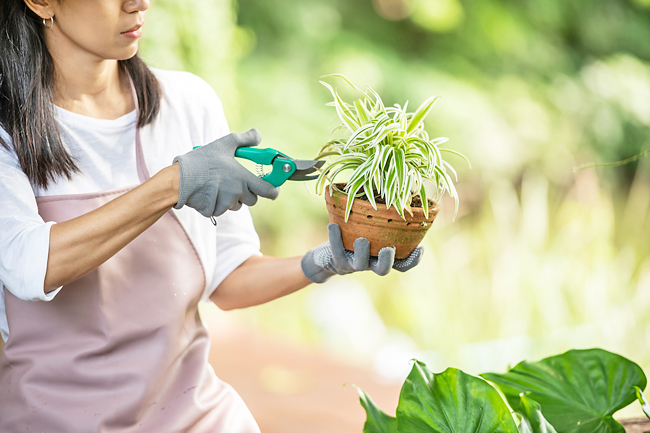THE STAR/DPA – Spring has arrived in the northern hemisphere, with the days getting longer, warmer and brighter. Not only are we humans awakening to the new season, but indoor plants are also stretching towards the sun.
However, they often get in their own way, something which can also happen in tropical countries. Is the foliage too thick, casting a shadow on the plant so it doesn’t get enough light? If so, this is precisely the right moment for some pruning.
WHY DO INDOOR PLANTS OCCASIONALLY NEED TO BE PRUNED?
“It serves the plant’s health,” said board member Andreas Hoefer of the Federal Association of Retail Gardeners in Berlin.
“They simply become more robust whenever they get trimmed.” The pruning animates the plant to sprout anew.

However, indoor plants should not be allowed to grow without limits. For one thing, in the house or apartment they usually have little room to spread out. If they keep sprouting and grow larger and broader, they will once again have to be trimmed back into shape, Hoefer noted.
At the same time, all indoor plants – whether they have room or not – in any event have little space for their roots to spread out. And if the plant on top is growing lushly, the roots also want to keep up.
Therefore the plant needs regular pruning in order to restore the right balance between the crown and the roots.
WHEN IS THE RIGHT TIME FOR PRUNING?
Robust house plants can be pruned at any time. But for most species the spring and summer seasons are ideal since that is when the vegetation period starts or is fully underway.
Light and warmth make it easier for plants to recover from the wounds left from the pruning. And as a result they sprout more compactly.
“In contrast to when pruning is done in the autumn, when plants in the following dark time of year develop only weak sprouts, they sprout more powerfully in the season of strong light,” said gardening consultant Martin Breidbach for the Home Ownership Association in Bonn.
WHICH PLANTS IN PARTICULAR BENEFIT FROM BEING PRUNED?
“All houseplants which split off into many branches, for example the ficus and aralia, stand to benefit,” said Hoefer.
When they grow strongly, form many branches and quickly gain in size, they can very well stand being pruned once or even twice a year.
Creepers can likewise be regularly pruned. Particularly easy to maintain during pruning are also dragon tree, philodendron, yucca and euphorbia.
WHICH PLANTS SHOULD NOT, OR ONLY VERY CAREFULLY, BE PRUNED?
Those are the plants which have only one vegetation point. This is when a trimming can go wrong when this point is cut out by accident.
“This is the case, for example, with a palm tree from whose trunk the palm frond grows out at one place,” Hoefer explained.
“Here, an individual frond may be cut off. But a complete pruning would be a serious intervention from which the plant could also die.”
Gardening advisor Breidbach adds: “By no means may orchids be pruned back.”
For their care, one might only pick away wilted leaves and remove the dried flower sprouts.
Also, grass of Parnassus, aroid palm and small round cacti may not be completely pruned back.
WHICH INSTRUMENT IS BETTER: KNIFE OR SCISSORS?
“What’s important is to cut the plants as gently as possible – with a clean cut,” Breidbach said. “A normal household scissors is not adequate here.”
The recommendation is for sharp knives, good gardening shears, and for strongly lignified branches, maybe also a saw. It’s best to disinfect the tool with boiling water or alcohol beforehand in order to kill any disease-spreading germs.
HOW DO I GO ABOUT IT?
Basically speaking, with suitable plants every sprout can be pruned.
“You look to see where the branching point is and cut it just above this spot,” Hoefer said.
Or, you cut closely above the “sleeping eyes” – the tiny leaves just emerging on the twigs out of which the shoots will later grow.
WILL THE PLANT DIE IF TOO MUCH IS PRUNED AWAY?
“As long as the root is alive, the plant will recover even after a radical pruning,” Breidbach said. “With the pruning, the plant is even stimulated to again sprout strongly and compactly. But if it is too weak, it can die.”
WHAT CARE DOES THE PLANT NEED AFTER PRUNING?
Both experts advised providing indoor plants with water and fertiliser as usual afterwards.
“However it needs to be remembered that they now need less water and fertiliser because not as much foliage is there that needs to be supplied,” Breidbach said.
CAN I MAKE USE OF THE TRIMMED-OFF STEMS?
“They can be used very well for propagating the plant,” Hoefer noted. Simply put a few branches in water, and soon roots will often form. Then put this new plant in a pot. “The advantage of this is that you get a new plant that looks exactly like, and has the same characteristics, as the old one.”






